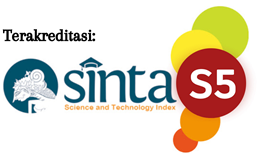Author Guidelines can be download with click template here.
Terms of submitting manuscript:
- Article is written originally by one or many writers in the scope of Teaching & Learning; Material Learning; Learning Media/Multimedia; Evaluation & Assessment; Higher Order Thinking Skills (HOTS); Science, Technology, Engineering, and Mathematics (STEM) Education; Chemical Content Learning Strategy; School Laboratory Experiment; Integrating Islamic Values with Chemistry. The article contains 8-13 pages. The article’s systematics consists of abstract, introduction, method, results and discussion, conclusion, and references.
- Manuscript is written in A4 paper with Times New Roman, 11 font size, single line spacing. The size of the left, the right, the upper, and bottom margins of 2.5 cm each.
- The title must be clear, short, informative, describe the research, no more than 15 words, including conjunctions. It is very important to avoid conjunctions and mention objects, places, or research materials in very detailed descriptions.
- Full paper can be written in Indonesian or English.
- Author(s) name is fully writen without any title.
- Institution is completely stated, including the study program and the institution name.
- Corresponding author: includes name, email address, and the address that can be used for for us to send you a journal.
Abstract:
Abstract consists of one important paragraph in an article that reflects the overall substance of the article content. Abstract must include background of the importance of research, research objectives, brief methods, brief findings, and brief conclusions.The abstract is written in two languages (English and Indonesian). Abstract of no more than 250 words, typed using Times New Roman 11, one spaced, justified, and written without indenting at the beginning of the paragraph.
Content:
The content of article consists of introduction, methode, results and discussion, conclution, acknowledgment, and references.
1. Introduction
The introduction mainly contains research problems, insights and problem-solving plans, State of the Art/overview of previous research (especially from scientific journal literature in the last 10 years) to support/strengthen statements justifying new contributions. Make sure it is also clearly stated "Gap Analysis/Novelty Analysis/Novelty Statement or Article Contribution Statement". At the end of the introduction, the research objectives/purpose of the study are clearly stated.
References and Citations are written using IEEE format. Quotations with more than one reference can be written with sequential numbers such as [1-3] or [1,2,5,7]. Make sure that only cited references are listed in References. It is recommended when entering quotes to use management references such as Mendeley, Zotero, End Note or others.
2. Method
The method used must be accompanied by a reference. Research methods are basically scientific methods that include rational, empirical and systematic ways to obtain data with specific purposes and uses. It is recommended to clearly state the time and place of research, research subjects and objects, research population and samples, research instruments, research tools and materials (if conducting laboratory studies). The process of data collection, data analysis and research results must be explained clearly and in detail and be easy for readers to understand.
3. Results and Discussion
The results and discussion contain an explanation of the research results which are analyzed and synthesized sharply and critically. The discussion must be enriched by referring to or comparing previous research results that have been published in reputable scientific journals and do not come from predatory journals. Results and discussion can be written using sub-chapters if there are several variables used. Tables and chart can be used to explain the result presented verbally, and should be commented or discussed.
4. Conclution
Conclusions are written clearly and concisely. Conclusions must be in accordance with the research objectives. Conclusions must be supported by sufficient research data. Conclusions are written in descriptive paragraph form, not in bullet-numbering form.
5. Acknowledgment (optional)
This section contains thanks to sponsors, fund donors, resource persons, or parties who played a very important role in carrying out the research.
6. References
Writing literature uses the IEEE Standard system. Everything referred to in the article must be written in the bibliography and vice versa, everything written in the bibliography must be referenced in the article. The bibliography must consist of at least 15 references with publications updated in the last 10 years. It is recommended to cite at least 2 articles from the Configuration Journal that are related to the author's research.
Reference sources should be taken from journal articles rather than books or proceedings. Authors are required to present a valid bibliography according to the original source. An example of writing a bibliography is as follows:
Articles from journals
[1] Author 1, Author 2, etc (abbreviated first name, last name), Article title, Journal name in italics, volume, number, page range, month, year.
Example :
[1] Z. Mukhtar, R. Emilia dan R. Silaban, “Pengembangan Penuntun Praktikum Model Discovery dan Project Based Learning Pada Pembelajaran Asam dan Basa di SMA Kelas XI, Jurnal Tabularasa PPS UNIMED, Vol. 12, No.3, pp: 294-304, Desember 2015.
Books
[2] Author 1, Author 2, etc., (abbreviated first name, last name), "Chapter Title in the book," book title, edition, Place of Publisher: Name of publisher, year, chapter, page range.
Example:
[2] W. Sanjaya, Penelitian Pendidikan: Jenis, Metode, Prosedur, Jakarta: Kencana, 2013, pp. 133-134.
Seminar/conference proceedings
[3] Author 1, Author 2, etc. (abbreviated first name, last name), article title, conference name, city, country, year, page range.
Thesis or dissertation
[4] Author (abbreviated first name, last name), abbreviated department, university, city, country, year of publication.













